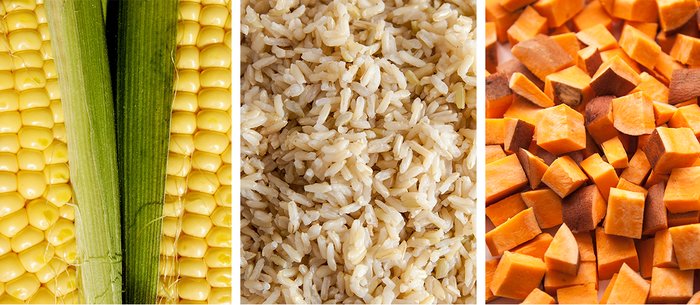As many of you know, there are really only two times of the day to take in simple carbohydrates: first thing in the morning and after your workout.
First thing in the morning because you are coming off a "fast"—which is how ever long you slept the night before. So, at that time you want a simple carbohydrate source and a quick digesting protein source. Now, if you plan on doing morning cardio, skip the carbs and have a small protein shake, then when you do your cardio you will be burning mostly fat for fuel. When you're done, have your carbs and protein.

After the workout is the other time to take in simple carbs: this is critical because it starts the whole recovery/muscle growth process. Following a hard workout, your body is severely depleted of glycogen and glucose.
During the workout hard working muscles use glucose (usable energy) and glycogen (stored energy) for energy. As such, there is a point at which blood glucose levels (available energy) and glycogen levels (stored energy) get so low that intense exercise can't continue. There just isn't enough available energy for your muscles to use.
So what happens is that the hormone cortisol is secreted, this is your body's "stress" hormone and it has very catabolic effects. What cortisol does is eat up muscle tissue for protein and convert it into glucose. A process called gluconeogenesis ensues, producing glucose from these amino acids in the liver. The net result is a loss of muscle tissue.
The post-workout shake prevents this. It also allows insulin to be released, this is, as most of you know, one of several anabolic hormones in the body (if you are a natural trainer especially, you want to maximize the release of all your body's anabolic hormones through all available methods).
So, whey protein is your best protein source at this time because it is absorbed quickly, what is the best carbohydrate source? Well, we want a high glycemic carbohydrate source. This term refers to carbs that are high on the glycemic index (70 and above rates as high).
The glycemic index is a measure of how quickly a food raises blood sugar and hence insulin levels. Normally, it is best to eat lower glycemic foods so as not to initiate an insulin spike (55 and under rates as low). But post-workout, the exact opposite is true.
It is critical to get the carbs (and protein) to the muscle cells as fast as possible. As well, the elevated insulin levels will help to drive nutrients into the muscle cells. And again, high-glycemic carbs are best for this purpose.
Simple Carbohydrates
Simple carbs are naturally present as simple sugars, occurring in mainly fruits and milk, as well as some other foods. The two main types of sugars are:
- Monosaccharides—consisting of a single sugar molecule.
- Disaccharides—consisting of a double sugar molecule.
Listed below are some common sugars:
Monosaccharide
Fructose—fruit sugar. You might think this would be a great source, but the glycemic index is only 11 for a 25 gram portion. This means then that it is not digested quickly and does not raise insulin levels to any great degree. What this means is that fruit sources are not a good source of carbs for the post-workout drink.
Dextrose—also known as glucose. You can buy this as a powder from various different sources. It has a rating of 96 for a 50 gram portion. This is one of the more common sugars used in post workout shakes. Dextrose is a good choice, however, some users find that they have a spill over effect that results in fat gain, so that makes more of an individual choice as you would have to test it and assess the results.
Disaccharides
Sucrose—this is common table sugar. It's made up of one molecule of glucose and one molecule of fructose. It has a rating of 60 for a 25 gram portion.
Lactose—milk sugar. This has a rating of only 48 for a 25 gram portion.
So as you can see, other than dextrose, most of these sources are not ideal as part of the post workout shake.
Complex Carbohydrates
Maltodextrin
Maltodextrin is actually a complex carbohydrate made from either corn, rice or potato starch, but its molecular chain is shorter than other complex carbs. As well, it consists of loosely bonded glucose molecules. And like dextrose, maltodextrin is absorbed directly through the gut. So it raises blood sugar and insulin levels as much as dextrose does.

However, before maltodextrin can be utilized, it must first pass through the liver for the bonds between the glucose molecules to be broken down. So the rate at which it is used for glycogen replenishment is slower than with dextrose. However, because it is metabolized slower, there will not be as quick of a drop of insulin and blood sugar levels as with dextrose. There appears to be no potential for fat gain from the use of maltodextrin.
Two Good Choices
So here we have two good choices: dextrose and maltodextrin. You can try each one and see which one seems to work better, but what has become a popular approach is to combine dextrose with maltodextrin, in a 50/50 combination. This makes sense because consumption of dextrose by itself can be inferior for several reasons.
First, studies show that gastric emptying (the process of digesting and emptying food out of the stomach) is slowed quite a bit when the concentration of dissolved particles in a solution (osmolarity) is raised.
Dextrose, being a single sugar molecule, will raise a solution's osmolarity, this in effect slows gastric emptying. Combining dextrose with a glucose polymer (a processed form of complex carbohydrates, in this case maltodextrin) allows more even digestion, with no slowing taking place. So this combination will optimize glycogen replenishment, hydration and performance.
I see this as still a great choice for post workout carbs, although somewhat outdated, considering the new advancements as we will look at next.
New Advancements
Waxy Maize
This is the newest carbohydrate product to hit the market. Waxy maize comes from corn starch and is absorbed very quickly: most carbohydrates are passed to the intestinal tract and broken down for digestion; waxy maize passes through the gastric lining without the need for gastric emptying other carbs require.
It also will allow other supplements, like creatine, to be absorbed more rapidly - Some well known formulas have this mix while many others do not; the others contain waxy maize by itself.
My conclusion on this form of carbohydrate is that it's great as part of a volumizing stack, or as a creatine loading product, to be taken during the day or even pre workout. While there does seem to be a common perception that waxy maize does not cause an insulin spike, my research for this article indicate that it does in fact cause an insulin spike.
As a post-workout source of carbs, this does seem to be the carb of choice right now. Take your time in choosing a product of this type, as the market is now flooded with them, you have recovery formulas, you have waxy maize formulas combining different simple carb sources with waxy maize, which could potentially cause a greater insulin response, you have some that are meant to be mixed with protein, some that aren't, some that mix poorly and clump all up and some that mix better.
I would rather make my own post-workout drink rather than buy a "recovery" drink, so I would pick one that mixes well, and that can be mixed with protein. Let's not forget how critical protein is to the post workout "window of opportunity", and that could mix with whatever else I wanted to toss in.

Carb To Protein Ratio
Now, what then are the optimal portions to take in regarding your protein/carbohydrate shake? Weight and training intensity are two factors that play a role here. Most sources suggest .25 (cutting) to .50 (mass gaining) per pound of lean body mass.
Protein should be in a ratio of 2 to 1, so if you have a lean body mass of 170 lb, this would mean 42 grams of carbs and 21 grams of protein if you are cutting, and 85 grams of carbs and 43 grams of protein if you are in a mass gaining cycle. This should be ingested within 30 minutes of training, and you should have a good meal within one hour of your shake.

